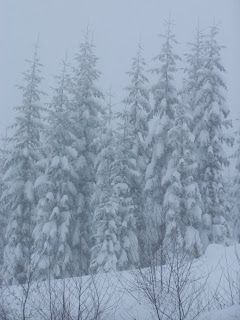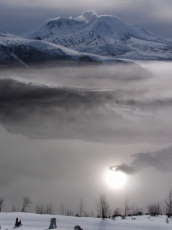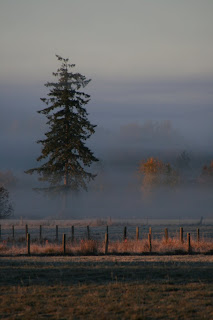 Downtown Winlock wears a significant mantle of snow on December 22nd, 2008.
Downtown Winlock wears a significant mantle of snow on December 22nd, 2008.Some however look at this week as a mere dusting compared to winters of the past. Some younger readers may remember the winter of 2003-2004 when a week of heavy weather struck the week after New Years. Most areas saw about 10 inches of snow followed by ice storms that knocked out power to 150,000 people in Southwest Washington.
 Able-bodied men shovel snow off of buildings in Downtown Winlock.
Able-bodied men shovel snow off of buildings in Downtown Winlock.The winter of 1968-69 was the last of the “deep freeze” events. For 18 days, Southwest Washington had temperatures that were below freezing including Portland’s all-time low of three degrees below zero and an equal number of days with snow on the ground. Oregon’s Rose City measured 8 to 14 inches on the ground most of that time period with a total of 18.9 inches of snowfall. Seattle reported 67 inches of snowfall. In my childhood days, I remember the snow depth in Eugene over my head.
 A winter scene on Olaqua Creek.
A winter scene on Olaqua Creek.Paul Foster of Winlock returned from a California logging operation to his King Road farm in the fall of 1968 and it soon began to snow. “We were never totally without snow on the ground until March,” he said. “We had 30 inches on the level,“ he explained. "That much snow was taking down old barns and chicken houses at that time,” Foster continued. “Every able-bodied person helped shovel off roofs”. Foster also explained how he would use his D-4 CAT and a piece of plywood to accelerate the snow removal process .
 Blue skies unfold a beautiful scene in December of 2008 in Western Washington.
Blue skies unfold a beautiful scene in December of 2008 in Western Washington.Locally, many folks responded with interest to stories of the winter of 1949-50. Statistically, it really started in earnest on January 13th. “The winds were coming out of the east and my dad said we were in for it,” said life-long Winlock resident Mike Porter who was 7 at the time. The temperature stayed below freezing and the snow started to pile up at their place on Hawkins Road. “We couldn’t get the old 39 Ford out of its parking place so we took a horse with a trailer to town,” he continued. “It was a wonderful time in life. We sat around the pot-bellied stove in the train station while the others shopped for supplies in Winlock. On the way home, we made deliveries to those that needed supplies”.

.JPG) Left-Adam Russell and Josh Lowman of Longview snowboard down Washington Street. Adam Russell of Winlock executes a jump with his snowboard on the Washington Street snow run in Winlock.
Left-Adam Russell and Josh Lowman of Longview snowboard down Washington Street. Adam Russell of Winlock executes a jump with his snowboard on the Washington Street snow run in Winlock.Foster recalled how a group of kids slid down the Washington Street “snowplay” area in Winlock and ended up in the garage of the Catholic Church two blocks from the base of the hill.
.JPG) Amber Paschich of Onalaska and Lydia Dolph slide down the Washington Street "Snowplay" area in Winlock in a rather unsuccessful manner.
Amber Paschich of Onalaska and Lydia Dolph slide down the Washington Street "Snowplay" area in Winlock in a rather unsuccessful manner.That winter supplied Portland 41 inches of snowfall, while Vancouver accumulated 35.3 inches. Seattle garnered a one day total of 21.4 inches of snowfall and a monthly total of 63.6 inches. In addition, winds blew so hard that snow drifts of five to six feet blossomed on the landscape creating the ingredients of the region’s only true blizzard that caused 13 deaths. Many low elevation locations reported snow depths that exceeded 50 inches.
 The sign still says "open" at Special Moments" in Downtown Winlock, despite icicles, snow and very little parking on a snow covered street in Downtown Winlock.
The sign still says "open" at Special Moments" in Downtown Winlock, despite icicles, snow and very little parking on a snow covered street in Downtown Winlock.35 years earlier, the winter of 1915-16 supplied Seattle with its largest one day total snowfall as 21.5 inches of snow fell on February 2nd, 1916 collapsing roof of the St. James Cathedral. In January and February of that year, a grand total of 58 inches of snow fell in Seattle and reports of 2 to 4 feet of snow depth in Western Washington was not uncommon. Portland counted 27.9 inches.
.JPG) Two deer lay in the snow on a side stree off Shannon Lewis Way in Winlock, Washington.
Two deer lay in the snow on a side stree off Shannon Lewis Way in Winlock, Washington.The 1880s were the good ol’ days of winter as Portland picked up 34.1 inches of snow during December of 1884. Seattle reported 47” of snow on the ground in January of 1880 and Bellingham reported “three weeks of snow” in January of 1871. Leaking into the next decade, Portland had its largest monthly snowfall total of 35.3 inches in January of 1890.
 One of the 600 pound chickens scattered around Winlock was wearing a mantle of snow.
One of the 600 pound chickens scattered around Winlock was wearing a mantle of snow. While many are debating this “La Nina” year and the prospects of a long drawn-out winter, one thing is for sure. History tells us about the potential of more winter to come as we enter the cold months of 2009.
































.jpg)




















